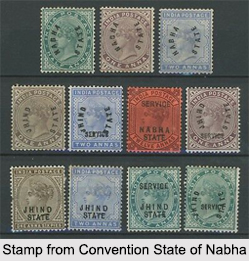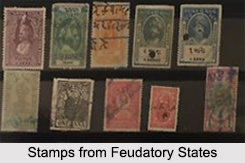 During the reign of the British East India Company, the British Empire lacked a uniform exercise of authority and many of the Indian states ran their own postal services. There were about 652 Princely States under the British government and most of them did not issue postage stamps.
During the reign of the British East India Company, the British Empire lacked a uniform exercise of authority and many of the Indian states ran their own postal services. There were about 652 Princely States under the British government and most of them did not issue postage stamps.
These states were divided into two main categories, first being the Convention States, had entered into a postal convention or agreement with the British government regarding mail. Secondly, there are the Feudatory States, who ran their own posts, and whose stamps were only valid within their borders.
Convention States
As per the postal convention between the British government and the few specific convention states, it was agreed that these states would overprint their names on the existing adhesive stamps and postal stationery of the British India. The practice of overprinting was referred to as "surcharging" though in most cases the monetary value of the postage stamp was never altered. These stamps were used within each Convention States and to other destinations within the territorial limits of British India. Listed below are some of the Convention States:
•Chamba (1887-1948)
•Faridkot (Feudatory from 1879-1887; convention from 1887 to 1901).
•Gwalior (1885-1948)
•Jind (Feudatory 1874 - 1885; convention from 1885).
•Nabha (1885-1948)
•Patiala (1884-1947)
 Feudatory States
Feudatory States
With their own unique designs and own postal services, the Feudatory States issued their own postage stamps, which were imperforate and without gum. The stamps of each Feudatory State were valid only within that State, so letters sent outside that State needed additional British India postage. Since many of the first stamp issues of these Feudatory states were printed locally, using primitive methods (generally typo graphed), they can be very rare. Due to the very basic nature of the printing and design, stamps of the Feudatory States are often informally referred to as "Uglies". Listed below are some of the Feudatory States:
•Alwar (1877-1899)
•Amb state (19th century- 1969)
•Bahawalpur (1945-1953)
•Bamra (1888-1893)
•Barwani (1921-1938)
•Bhopal (1876-1932)
•Bhor (1879-1901)
•Bijawar (1935-1937)
•Bundi (1894-1941)
•Bashahr (1895-1900)
•Charkari (1894-1943)
•Cochin (1892-1949)
•Dhar (1897-1898)
•Duttia (1893-1916)
•Faridkot (1879-1886) (a convention state from 1887)
•Hyderabad (1869-1949)
•Idar (1939-1944)
•Indore (1886-1941)
•Jaipur (1900-1947)
•Jammu (1866-1877)
•Jammu and Kashmir (1878-1886)
•Jasdan (1942-1942)
•Jhalawar (1887-1887)
•Jind (1874-1885) (a convention state from 1885)
•Junagadh (1864 - 1868) (from 1877: see Soruth)
•Kashmir (1866-1867)
•Kalat (1666-1955)
•Khairpur (1775-1955)
•Kishangarh (1899-1928)
•Las Bela (1897-1904)
•Morvi (1931-1935)
•Nandgaon (1892-1893)
•Nowanuggur (1877-1893)
•Orchha (1913-1939)
•Poonch (1876-1884)
•Rajasthan (1948-1949)
•Rajpeepla (1880)
•Sirmur (1879-1899)
•Soruth (1864-1937)
•Travancore (1888-1946)
•Travancore- Cochin (1949-1950)
•Wadhwan (1888-1889)















